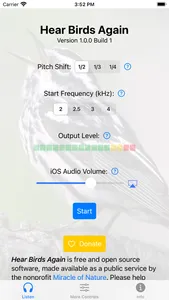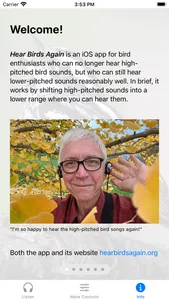Hear Birds Again is a free, open-source iOS mobile application for bird enthusiasts who suffer from high frequency hearing loss and desire to once again enjoy the uplifting songs of wild birds. It works by using advanced algorithms to lower the pitch of bird songs in real time, thereby making them audible during walks in nature.
The Problem: High Frequency Hearing Loss
As we grow older, we experience diminished sensitivity to high frequency sounds. Youthful hearing extends as high as 20,000 Hz (Hz = cycles/second). However, the average person over fifty or sixty years of age (especially among men) has completely lost the very highest frequencies and often suffers significant hearing loss in the range from 4,000 to 10,000 Hz. Loss of hearing with age, a condition technically referred to as “presbycusis,” is a widespread phenomenon that seemingly cannot be avoided. This is NOT good news for aging birdwatchers for the simple reason that most birds (especially songbirds) are difficult to spot and are generally discovered and identified by hearing their songs.
The average frequency of the songs of songbirds is around 3500 to 4000 Hz, approximately the same pitch as the highest note of a piano. Many warblers, sparrows, waxwings, kinglets, and a number of other birds produce sounds that reach 8,000 Hz and above. It follows that significant hearing loss above around 3000 Hz spells disaster for those interested in birding by ear, making it nearly impossible to hear the songs of a great number of species in normal outdoor situations. This can be especially painful for older people who are new to birding, many of whom quickly discover that they cannot hear what “most everyone else is raving about” and are thus unable to share in the excitement.
Solutions:
Conventional amplifying-type hearing aids may be a good solution if one's hearing loss in the high range is mild. Unfortunately, many birders have more severe loss that is not easily solved by making them louder. High amplification can be very annoying because other environmental sounds, such as the sound made by walking in leaves, are also amplified, leading to sensory overload. In addition, to avoid deafening feedback squeal, amplifying aids must usually be fitted so tightly that they plug the ears, blocking one's normal hearing. Furthermore, when bird songs are amplified to very high levels, they can easily overwhelm the senses, and it becomes difficult if not impossible to actually find and locate the birds.
Our pitch-lowering solution sidesteps these problems by lowering the bird songs into the range where one's hearing is normal or near-normal. The pitch-lowered songs are transparently mixed with what one is naturally hearing. Furthermore, by using our recommended open-air "binaural" headset (which is equipped with super low-noise mics), a realistic three-dimensional sound field is preserved, allowing for soft and distant sounds to be heard and the singers to be located and observed. Extraneous sounds like the rustle of leaves or the snapping of twigs will not be annoying. There will be no uncomfortable plugging of the ears. Sensory overload will be completely avoided, feedback squeal will not occur, and the overall effect will be gentle, natural and spacious.
For bird enthusiasts who suffer from moderate to severe high frequency hearing loss but who still have fairly normal hearing up to around 2000-2500Hz, Hear Birds Again, when used in conjunction with a well-designed binaural headset, will provide an excellent solution to the problem of bringing back the high singing birds.
The Problem: High Frequency Hearing Loss
As we grow older, we experience diminished sensitivity to high frequency sounds. Youthful hearing extends as high as 20,000 Hz (Hz = cycles/second). However, the average person over fifty or sixty years of age (especially among men) has completely lost the very highest frequencies and often suffers significant hearing loss in the range from 4,000 to 10,000 Hz. Loss of hearing with age, a condition technically referred to as “presbycusis,” is a widespread phenomenon that seemingly cannot be avoided. This is NOT good news for aging birdwatchers for the simple reason that most birds (especially songbirds) are difficult to spot and are generally discovered and identified by hearing their songs.
The average frequency of the songs of songbirds is around 3500 to 4000 Hz, approximately the same pitch as the highest note of a piano. Many warblers, sparrows, waxwings, kinglets, and a number of other birds produce sounds that reach 8,000 Hz and above. It follows that significant hearing loss above around 3000 Hz spells disaster for those interested in birding by ear, making it nearly impossible to hear the songs of a great number of species in normal outdoor situations. This can be especially painful for older people who are new to birding, many of whom quickly discover that they cannot hear what “most everyone else is raving about” and are thus unable to share in the excitement.
Solutions:
Conventional amplifying-type hearing aids may be a good solution if one's hearing loss in the high range is mild. Unfortunately, many birders have more severe loss that is not easily solved by making them louder. High amplification can be very annoying because other environmental sounds, such as the sound made by walking in leaves, are also amplified, leading to sensory overload. In addition, to avoid deafening feedback squeal, amplifying aids must usually be fitted so tightly that they plug the ears, blocking one's normal hearing. Furthermore, when bird songs are amplified to very high levels, they can easily overwhelm the senses, and it becomes difficult if not impossible to actually find and locate the birds.
Our pitch-lowering solution sidesteps these problems by lowering the bird songs into the range where one's hearing is normal or near-normal. The pitch-lowered songs are transparently mixed with what one is naturally hearing. Furthermore, by using our recommended open-air "binaural" headset (which is equipped with super low-noise mics), a realistic three-dimensional sound field is preserved, allowing for soft and distant sounds to be heard and the singers to be located and observed. Extraneous sounds like the rustle of leaves or the snapping of twigs will not be annoying. There will be no uncomfortable plugging of the ears. Sensory overload will be completely avoided, feedback squeal will not occur, and the overall effect will be gentle, natural and spacious.
For bird enthusiasts who suffer from moderate to severe high frequency hearing loss but who still have fairly normal hearing up to around 2000-2500Hz, Hear Birds Again, when used in conjunction with a well-designed binaural headset, will provide an excellent solution to the problem of bringing back the high singing birds.
Show More


